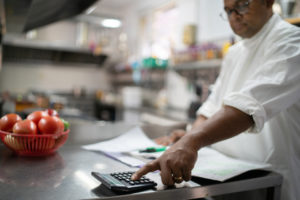
Dirk Ahlbeck, CPA | Principal | National Restaurant Practice Lead
Maintaining a successful restaurant with inflation increasing the costs of goods and services is no easy task, especially after navigating a pandemic which closed restaurant operations in early 2020. The rising costs of food supplies can create an unstable environment without an annual forecasting and budgeting strategy to control these costs. To grow a restaurant’s margins for continued growth, owners and operators should practice forecasting for food supplies which allows better decision making throughout the year and can identify opportunities for business changes.
Restaurants’ food costs are also known as Cost of Goods Sold (COGS) and food costs are a percentage of the restaurant’s percentage of sales. The establishment’s COGS can be both actual and theoretical, based on forecasting and seasonal menu changes.
For eateries to maintain an accurate COGS forecast; recipe costing is key. This process is when a restaurant breaks down menu items with the correct cost for portion sizes and individual ingredients (cost out menu). The restaurant should have up-to-date information on vendor pricing for ingredients and supply costs which combined with standardized recipes, owners can properly forecast the COGS for a 12-month period, maintaining all menu items are consistent. A significant key to success with recipe costing is ensuring employees are responsible managing food and ingredients with minimal waste, spoilage, shrinkage, and improper portioning. Owners and operators should ensure all employees are properly trained on menu portioning and enact internal controls to ensure consistency throughout.
One modern tool for managing COGS is investing in inventory management software. Often, inventory management software programs will also integrate with accounting and Point of Sale (POS) systems. The main benefit of an inventory management program is the accuracy of reporting, instead of calculating manually. Programs will also notify owners of item analysis, to ensure supply ordering is in sync with the restaurant’s demand.
Another best practice for restaurant operators is understanding the difference between actual inventory and recipe costs. This practice reveals the source of unexpected costs and could create opportunities for savings. The first step is identifying the theoretical food costs as a percentage of total sales. Theoretical food costs are calculated assuming all menu items are made in perfect portion sizes, including no waste, mistakes, or theft. Establishing the menu’s theoretical food cost will provide a blueprint for actual inventory and recipe costs; the theoretical food cost acts as a baseline for production and added costs will cover assumed waste, mistakes, theft, and going over in set portion size.
Once the restaurant’s food prices are understood and tracked accordingly, the next step is ensuring menu pricing is aligned with food costs in mind. For healthy margins, restaurants should aim to keep food cost percentage around 28 – 32%. Percentages will differ between the type of restaurant, such as quick service or fine dining, as well as location and hours of operation (i.e.: only open for breakfast and lunch, etc.). Accurate menu pricing will ensure each menu item contributes to the profit margin, along with identifying plates to be expired or discontinued if not contributing to the financial success of the eatery. Menu engineering may be required to ensure each option is profitable and not wasting both menu space and inventory costs in the current state of inflation.
An innovative strategy to support forecasting and offset increasing supply spend is to increase the restaurant’s overall revenue. Begin by exploring options with takeout and delivery services to identify if additional revenue streams can be achieved in the quarter, which could potentially double sales with additional meals ordered without taking up a valuable table for in-person dining.
Annual forecasting and budgeting are critical components of controlling food costs and pave the way for better margins and continued growth. Evaluating different methods for consistent ordering, waste control, and increasing revenue can establish a healthy outcome for restaurants in 2023 and beyond.

